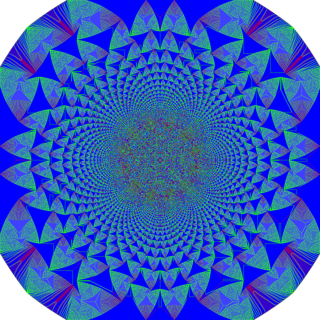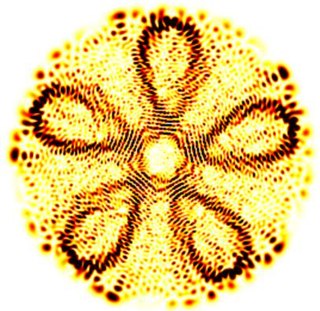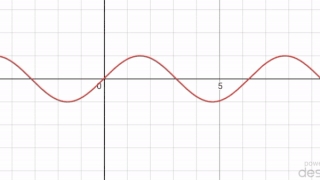
The edge of chaos is a transition space between order and disorder that is hypothesized to exist within a wide variety of systems. This transition zone is a region of bounded instability that engenders a constant dynamic interplay between order and disorder.

Self-organized criticality (SOC) is a property of dynamical systems that have a critical point as an attractor. Their macroscopic behavior thus displays the spatial or temporal scale-invariance characteristic of the critical point of a phase transition, but without the need to tune control parameters to a precise value, because the system, effectively, tunes itself as it evolves towards criticality.
Numerical relativity is one of the branches of general relativity that uses numerical methods and algorithms to solve and analyze problems. To this end, supercomputers are often employed to study black holes, gravitational waves, neutron stars and many other phenomena governed by Einstein's theory of general relativity. A currently active field of research in numerical relativity is the simulation of relativistic binaries and their associated gravitational waves.
Bremermann's limit, named after Hans-Joachim Bremermann, is a limit on the maximum rate of computation that can be achieved in a self-contained system in the material universe. It is derived from Einstein's mass-energy equivalency and the Heisenberg uncertainty principle, and is c2/h ≈ 1.36 × 1050 bits per second per kilogram.

The Zaslavskii map is a discrete-time dynamical system introduced by George M. Zaslavsky. It is an example of a dynamical system that exhibits chaotic behavior. The Zaslavskii map takes a point in the plane and maps it to a new point:
In chaos theory, the correlation dimension is a measure of the dimensionality of the space occupied by a set of random points, often referred to as a type of fractal dimension.

J. Doyne Farmer is an American complex systems scientist and entrepreneur with interests in chaos theory, complexity and econophysics. He is Baillie Gifford Professor of Mathematics at Oxford University, where he is also Director of the Complexity Economics at the Institute for New Economic Thinking at the Oxford Martin School. Additionally he is an external professor at the Santa Fe Institute. His current research is on complexity economics, focusing on systemic risk in financial markets and technological progress. During his career he has made important contributions to complex systems, chaos, artificial life, theoretical biology, time series forecasting and econophysics. He co-founded Prediction Company, one of the first companies to do fully automated quantitative trading. While a graduate student he led a group that called itself Eudaemonic Enterprises and built the first wearable digital computer, which was used to beat the game of roulette.
PVLAS aims to carry out a test of quantum electrodynamics and possibly detect dark matter at the Department of Physics and National Institute of Nuclear Physics in Ferrara, Italy. It searches for vacuum polarization causing nonlinear optical behavior in magnetic fields. Experiments began in 2001 at the INFN Laboratory in Legnaro and continue today with new equipment.
Dissipative solitons (DSs) are stable solitary localized structures that arise in nonlinear spatially extended dissipative systems due to mechanisms of self-organization. They can be considered as an extension of the classical soliton concept in conservative systems. An alternative terminology includes autosolitons, spots and pulses.
Peter Grassberger is a professor well known for his work in statistical and particle physics. He is most famous for his contributions to chaos theory, where he introduced the idea of correlation dimension, a means of measuring a type of fractal dimension of the strange attractor.
Differential dynamic microscopy (DDM) is an optical technique that allows performing light scattering experiments by means of a simple optical microscope. DDM is suitable for typical soft materials such as for instance liquids or gels made of colloids, polymers and liquid crystals but also for biological materials like bacteria and cells.
Surrogate data, sometimes known as analogous data, usually refers to time series data that is produced using well-defined (linear) models like ARMA processes that reproduce various statistical properties like the autocorrelation structure of a measured data set. The resulting surrogate data can then for example be used for testing for non-linear structure in the empirical data, see surrogate data testing.

Quantum scarring refers to a phenomenon where the eigenstates of a classically chaotic quantum system have enhanced probability density around the paths of unstable classical periodic orbits. The instability of the periodic orbit is a decisive point that differentiates quantum scars from the more trivial observation that the probability density is enhanced in the neighborhood of stable periodic orbits. The latter can be understood as a purely classical phenomenon, a manifestation of the Bohr correspondence principle, whereas in the former, quantum interference is essential. As such, scarring is both a visual example of quantum-classical correspondence, and simultaneously an example of a (local) quantum suppression of chaos.

In mathematics, a periodic travelling wave is a periodic function of one-dimensional space that moves with constant speed. Consequently, it is a special type of spatiotemporal oscillation that is a periodic function of both space and time.

Chung-Kang Peng is the Director of the Center for Dynamical Biomarkers at Beth Israel Deaconess Medical Center / Harvard Medical School (BIDMC/HMS). Under his direction the Center for Dynamical Biomarkers researches fundamental theories and novel computational algorithms for characterizing physiological states in terms of their dynamical properties. He is also currently the K.-T. Li Visiting Chair Professor at National Central University (NCU), Visiting Chair Professor at National Chiao Tung University (NCTU) in Taiwan, and Visiting Professor at China Academy of Chinese Medical Sciences in China. During 2012–2014, he served as the founding Dean of the College of Health Sciences and Technology at NCU in Taiwan.

In mathematics, a strange nonchaotic attractor (SNA) is a form of attractor which, while converging to a limit, is strange, because it is not piecewise differentiable, and also non-chaotic, in that its Lyapunov exponents are non-positive. SNAs were introduced as a topic of study by Grebogi et al. in 1984. SNAs can be distinguished from periodic, quasiperiodic and chaotic attractors using the 0-1 test for chaos.
Dwight Barkley is a professor of mathematics at the University of Warwick.
The Kundu equation is a general form of integrable system that is gauge-equivalent to the mixed nonlinear Schrödinger equation. It was proposed by Anjan Kundu as
Bernstein–Greene–Kruskal modes are nonlinear electrostatic waves that propagate in an unmagnetized, collisionless plasma. They are nonlinear solutions to the Vlasov–Poisson equation in plasma physics, and are named after physicists Ira B. Bernstein, John M. Greene, and Martin D. Kruskal, who solved and published the exact solution for the one-dimensional case in 1957.
In fractal geometry, the Higuchi dimension is an approximate value for the box-counting dimension of the graph of a real-valued function or time series. This value is obtained via an algorithmic approximation so one also talks about the Higuchi method. It has many applications in science and engineering and has been applied to subjects like characterizing primary waves in seismograms, clinical neurophysiology and analyzing changes in the electroencephalogram in Alzheimer’s disease.








